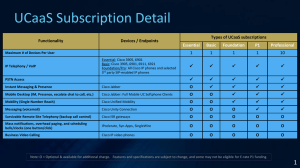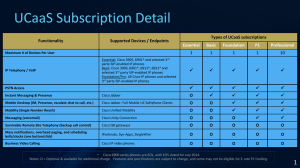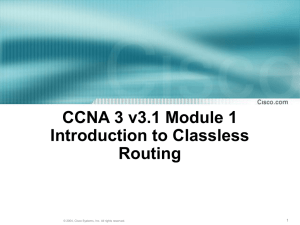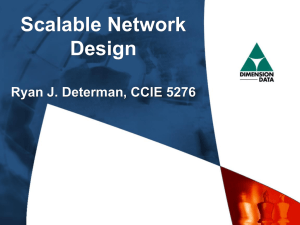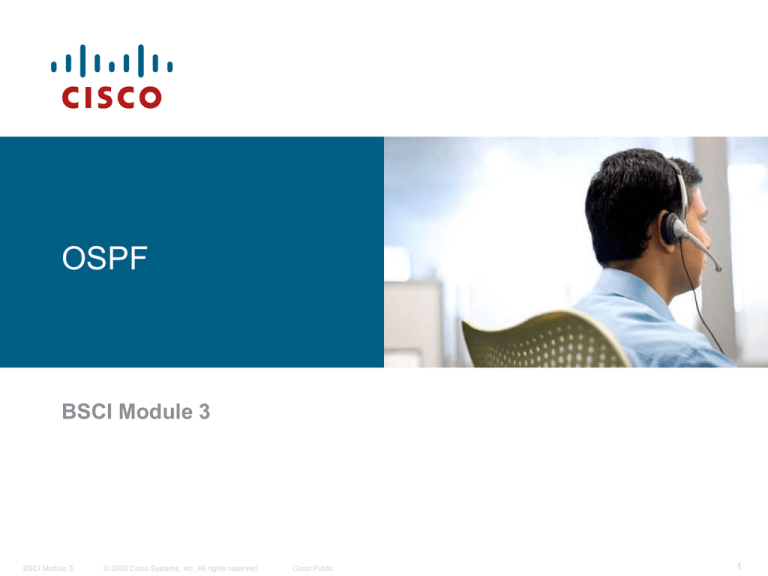
OSPF
BSCI Module 3
BSCI Module 3
© 2006 Cisco Systems, Inc. All rights reserved.
Cisco Public
1
Purpose of this Lesson
Coverage of topics new to the “OSPF” module of BSCI.
What’s new in this module?
Some new terminology and acronyms
More detailed explanation of LSAs and the Link-state Database
Several new OSPF configuration and verification commands
OSPF authentication configuration and verification commands
BSCI Module 3
© 2006 Cisco Systems, Inc. All rights reserved.
Cisco Public
2
Basic OSPF
Configuration
BSCI Module 3
© 2006 Cisco Systems, Inc. All rights reserved.
Cisco Public
3
Configuring OSPF
An excellent resource for information on the many
different OSPF configurations is the Cisco white paper,
“Configuring OSPF”, which can be downloaded from
the Cisco website:
http://www.cisco.com/en/US/products/sw/iosswrel/ps1835/produ
cts_configuration_guide_chapter09186a00800b3f2e.html
BSCI Module 3
© 2006 Cisco Systems, Inc. All rights reserved.
Cisco Public
4
Configuring Basic OSPF
Router(config)#
router ospf process-id [vrf vpn-name]
Enable one or more OSPF routing processes.
Router(config-router)#
network ip-address wildcard-mask area area-id
Define the interfaces that OSPF will run on.
Router(config-if)#
ip ospf process-id area area-id [secondaries none]
Optional method to enable OSPF explicitly on an
interface.
BSCI Module 3
© 2006 Cisco Systems, Inc. All rights reserved.
Cisco Public
5
OSPF Areas
Review of OSPF area characteristics:
Minimizes routing
table entries
Localizes impact of
a topology change
within an area
Detailed LSA
flooding stops at
the area boundary
Requires a
hierarchical
network design
BSCI Module 3
© 2006 Cisco Systems, Inc. All rights reserved.
Cisco Public
6
OSPF Areas
New terminology for areas:
Transit Area
Also known as
Backbone Area 0
Regular Area
Also known as
Nonbackbone areas
BSCI Module 3
© 2006 Cisco Systems, Inc. All rights reserved.
Cisco Public
7
Configuring OSPF for Multiple Areas
network 10.2.1.0 0.0.0.3 area 1
BSCI Module 3
© 2006 Cisco Systems, Inc. All rights reserved.
Cisco Public
8
OSPF Router ID
The router is known to OSPF by the OSPF router ID number.
LSDBs use the OSPF router ID to differentiate one router from
the next.
By default, the router ID is the highest IP address on an active
interface at the moment of OSPF process startup.
If no interface is up when the OSPF process starts, you will get the following error message:
p5r2(config)#router ospf 1
2w1d: %OSPF-4-NORTRID: OSPF process 1 cannot start.
A loopback interface can override the OSPF router ID. If a
loopback interface exists, the router ID is the highest IP address
on any active loopback interface.
The OSPF router-id command can be used to override the
OSPF router ID.
Using a loopback interface or a router-id command is
recommended for stability.
BSCI Module 3
© 2006 Cisco Systems, Inc. All rights reserved.
Cisco Public
9
OSPF router-id Command
Router(config-router)#
router-id ip-address
This command is configured under the router ospf [processid] command.
Any unique arbitrary 32-bit value in an IP address format (dotted
decimal) can be used.
If this command is used on an OSPF process that is already active,
then the new router ID takes effect after the next reload or after a
manual restarting of the OSPF process using:
Router#clear ip ospf process
Router(config)#router ospf 1
Router(config-router)#router-id 172.16.1.1
Router#clear ip ospf process
BSCI Module 3
© 2006 Cisco Systems, Inc. All rights reserved.
Cisco Public
10
NBMA OSPF
Configuration
BSCI Module 3
© 2006 Cisco Systems, Inc. All rights reserved.
Cisco Public
11
OSPF over NBMA Topology Modes of
Operation
RFC 2328-compliant modes are as follows:
Nonbroadcast (NBMA)
Point-to-multipoint
Additional modes from Cisco are as follows:
Point-to-multipoint nonbroadcast
Broadcast
Point-to-point
Router(config-if)#
ip ospf network [{broadcast | non-broadcast | point-tomultipoint [non-broadcast] | point-to-point}]
This interface command defines OSPF network type.
BSCI Module 3
© 2006 Cisco Systems, Inc. All rights reserved.
Cisco Public
12
RFC-compliant Non-broadcast Mode
One IP subnet.
Neighbors must be manually
configured.
DR and BDR elected.
DR and BDR need to have full
connectivity with all other
routers.
Typically used in a full mesh
topology.
RTB(config-if)#ip ospf network non-broadcast
-------RTB(config-router)#network 3.1.1.0 0.0.0.255 area 0
RTB(config-router)#neighbor 3.1.1.1
RTB(config-router)#neighbor 3.1.1.3
BSCI Module 3
© 2006 Cisco Systems, Inc. All rights reserved.
Cisco Public
13
RFC-compliant Point-to-Multipoint Mode
One IP subnet.
Uses multicast OSPF hello
packet to automatically
discover neighbors.
DR and BDR not required
Typically used in a partialmesh or hub-and-spoke
topology.
RTB(config-if)#ip ospf network point-to-multipoint
-------RTB(config-router)#network 3.1.1.0 0.0.0.255 area 0
BSCI Module 3
© 2006 Cisco Systems, Inc. All rights reserved.
Cisco Public
14
Cisco’s Point-to-Multipoint Non-broadcast mode
Cisco extension to RFC-compliant
point-to-multipoint mode
Must statically define neighbors,
like nonbroadcast mode
Like point-to-multipoint mode,
DR/BDR not elected
Used in special cases where
neighbors
cannot be automatically
discovered
RTB(config-if)#ip ospf network point-to-multipoint nonbroadcast
-------RTB(config-router)#network 3.1.1.0 0.0.0.255 area 0
RTB(config-router)#neighbor 3.1.1.1 cost 10
RTB(config-router)#neighbor 3.1.1.3 cost 20
BSCI Module 3
© 2006 Cisco Systems, Inc. All rights reserved.
Cisco Public
15
Cisco’s Broadcast Mode
Makes a WAN interface
appear to be a LAN
One IP subnet
Uses multicast hellos to
discover neighbors
DR and BDR elected
Requires a full mesh.
RTB(config-if)#ip ospf network broadcast
-------RTB(config-router)#network 3.1.1.0 0.0.0.255 area 0
BSCI Module 3
© 2006 Cisco Systems, Inc. All rights reserved.
Cisco Public
16
Cisco’s Point-to-Point mode
One IP subnet per subinterface pair
No DR or BDR election
Used when only two routers need to
form an adjacency on a pair of
interfaces
Same properties as any physical
point-to-point physical interface
RTB(config)#interface serial 0/0.1
RTB(config-subif)#ip address 3.1.1.2 255.255.255.0
RTB(config-subif)#interface serial 0/0.2
RTB(config-subif)#ip address 4.1.1.2 255.255.255.0
-------RTB(config-router)#network 3.1.1.0 0.0.0.255 area 0
RTB(config-router)#network 4.1.1.0 0.0.0.255 area 0
BSCI Module 3
© 2006 Cisco Systems, Inc. All rights reserved.
Cisco Public
17
Using the neighbor Command
Router(config-router)#
neighbor ip-address [priority number] [poll-interval
number] [cost number] [database-filter all]
Used to statically define neighbor relationships in an
NBMA network
BSCI Module 3
© 2006 Cisco Systems, Inc. All rights reserved.
Cisco Public
18
The neighbor command options
Router(config-router)#
neighbor ip-address [priority number] [poll-interval
number] [cost number] [database-filter all]
Option
Description
priority number
Specifies the priority of neighbor. Default is zero,
which means neighbor can never be DR.
poll-interval
number
Amount of time a NBMA interface waits before
sending hellos to the neighbor even if the neighbor is
inactive.
cost number
Assigns a cost to the neighbor from 1 to 65535.
Neighbors with no specific cost configured will
assume the cost of the interface, based on the ip
ospf cost command. (Not used with NBMA)
database-filter all
Filters outgoing LSAs to an OSPF neighbor
BSCI Module 3
© 2006 Cisco Systems, Inc. All rights reserved.
Cisco Public
19
OSPF over NBMA Topology Summary
BSCI Module 3
© 2006 Cisco Systems, Inc. All rights reserved.
Cisco Public
20
OSPF
Authentication
BSCI Module 3
© 2006 Cisco Systems, Inc. All rights reserved.
Cisco Public
21
OSPF Authentication Types
• OSPF supports 2 types of authentication:
•Simple password authentication (plain text)
•MD5 authentication
• Router generates and checks each packet and authenticates the
source of each update packet it receives
• Configure a “key” (password)
•Note: all participating neighbors must have the same key
configured
BSCI Module 3
© 2006 Cisco Systems, Inc. All rights reserved.
Cisco Public
22
Configuring Simple Password Authentication
Router(config-if)#
ip ospf authentication-key password
• Assign a password to be used with neighboring routers.
Router(config-if)#
ip ospf authentication [message-digest | null]
• Specifies the authentication type for an interface
(since IOS 12.0).
Router(config-router)#
area area-id authentication [message-digest]
• Specifies the authentication type for an area (was in IOS
before 12.0).
BSCI Module 3
© 2006 Cisco Systems, Inc. All rights reserved.
Cisco Public
23
Example Simple Password Authentication
Configuration
BSCI Module 3
© 2006 Cisco Systems, Inc. All rights reserved.
Cisco Public
24
R2 Configuration for Simple Password
Authentication
<output omitted>
interface Loopback0
ip address 10.2.2.2 255.255.255.0
<output omitted>
interface Serial0/0/1
ip address 192.168.1.102 255.255.255.224
ip ospf authentication
ip ospf authentication-key plainpas
<output omitted>
router ospf 10
log-adjacency-changes
network 10.2.2.2 0.0.0.0 area 0
network 192.168.1.0 0.0.0.255 area 0
BSCI Module 3
© 2006 Cisco Systems, Inc. All rights reserved.
Cisco Public
25
Verifying Simple Password Authentication
R1#sh ip ospf neighbor
Neighbor ID
Pri
State
10.2.2.2
0
FULL/
-
Dead Time
00:00:32
Address
192.168.1.102
Interface
Serial0/0/1
R1#show ip route
<output omitted>
Gateway of last resort is not set
10.0.0.0/8 is variably subnetted, 2 subnets, 2 masks
O
10.2.2.2/32 [110/782] via 192.168.1.102, 00:01:17, Serial0/0/1
C
10.1.1.0/24 is directly connected, Loopback0
192.168.1.0/27 is subnetted, 1 subnets
C
192.168.1.96 is directly connected, Serial0/0/1
R1#ping 10.2.2.2
Type escape sequence to abort.
Sending 5, 100-byte ICMP Echos to 10.2.2.2, timeout is 2 seconds:
!!!!!
Success rate is 100 percent (5/5), round-trip min/avg/max = 28/29/32 ms
BSCI Module 3
© 2006 Cisco Systems, Inc. All rights reserved.
Cisco Public
26
Configuring OSPF MD5 Authentication
Router(config-if)#
ip ospf message-digest-key key-id md5 key
• Assign a key ID and key to be used with neighboring routers.
Router(config-if)#
ip ospf authentication [message-digest | null]
• Specifies the authentication type for an interface
(since IOS 12.0).
Router(config-router)#
area area-id authentication [message-digest]
• Specifies the authentication type for an area (was in IOS
before 12.0).
BSCI Module 3
© 2006 Cisco Systems, Inc. All rights reserved.
Cisco Public
27
Example MD5 Authentication
Configuration
BSCI Module 3
© 2006 Cisco Systems, Inc. All rights reserved.
Cisco Public
28
R2 Configuration for MD5 Authenticaiton
<output omitted>
interface Loopback0
ip address 10.2.2.2 255.255.255.0
<output omitted>
interface Serial0/0/1
ip address 192.168.1.102 255.255.255.224
ip ospf authentication message-digest
ip ospf message-digest-key 1 md5 secretpass
<output omitted>
router ospf 10
log-adjacency-changes
network 10.2.2.2 0.0.0.0 area 0
network 192.168.1.0 0.0.0.255 area 0
BSCI Module 3
© 2006 Cisco Systems, Inc. All rights reserved.
Cisco Public
29
Verifying MD5 Authentication
R1#sho ip ospf neighbor
Neighbor ID
Pri
State
10.2.2.2
0
FULL/
-
Dead Time
00:00:31
Address
192.168.1.102
Interface
Serial0/0/1
R1#show ip route
<output omitted>
Gateway of last resort is not set
10.0.0.0/8 is variably subnetted, 2 subnets, 2 masks
O
10.2.2.2/32 [110/782] via 192.168.1.102, 00:00:37, Serial0/0/1
C
10.1.1.0/24 is directly connected, Loopback0
192.168.1.0/27 is subnetted, 1 subnets
C
192.168.1.96 is directly connected, Serial0/0/1
R1#ping 10.2.2.2
Type escape sequence to abort.
Sending 5, 100-byte ICMP Echos to 10.2.2.2, timeout is 2 seconds:
!!!!!
Success rate is 100 percent (5/5), round-trip min/avg/max = 28/28/32 ms
BSCI Module 3
© 2006 Cisco Systems, Inc. All rights reserved.
Cisco Public
30
Changing Cost
BSCI Module 3
© 2006 Cisco Systems, Inc. All rights reserved.
Cisco Public
31
Changing the Cost Metric
The cost, or metric, is an indication of the overhead to
send packets over an interface. Default = (100
Mbps)/(bandwidth in Mbps).
RouterA(config-router)#
auto-cost reference-bandwidth ref-bw
Sets the reference bandwidth to values other than 100
Mbps (legal values range from 1 to 4,294,967 in Mbps).
RouterA(config-if)#
ip ospf cost interface-cost
Overrides the default cost calculation. Values from 1 to
65535 can be defined.
BSCI Module 3
© 2006 Cisco Systems, Inc. All rights reserved.
Cisco Public
32
Propagating Default
Routes in NSSAs
BSCI Module 3
© 2006 Cisco Systems, Inc. All rights reserved.
Cisco Public
33
Stub Area Configuration
RouterA(config-router)#
area area-id nssa [no-redistribution] [defaultinformation-originate [metric metric-value] [metric-type
type-value]] [no-summary]
To configure a stub area use the area
command on both routers.
<area-id>
stub
no-summary creates a totally stubby area; this is a Cisco
proprietary feature.
BSCI Module 3
© 2006 Cisco Systems, Inc. All rights reserved.
Cisco Public
34
NSSA Configuration
RouterA(config-router)#
area area-id nssa [no-redistribution] [defaultinformation-originate [metric metric-value] [metric-type
type-value]] [no-summary]
Use this command instead of the area
command to define the area as NSSA.
<area-id>
nssa
NSSA areas allow for Type 5 Autonomous System
External LSAs
BSCI Module 3
© 2006 Cisco Systems, Inc. All rights reserved.
Cisco Public
35
Example: NSSA Configuration
BSCI Module 3
© 2006 Cisco Systems, Inc. All rights reserved.
Cisco Public
36
LSA Types
BSCI Module 3
© 2006 Cisco Systems, Inc. All rights reserved.
Cisco Public
37
Virtual Link Concepts
and Configuration
BSCI Module 3
© 2006 Cisco Systems, Inc. All rights reserved.
Cisco Public
38
Virtual Links
Virtual links are used to connect a discontiguous area
to area 0.
A logical connection is built between router A and router
B.
Virtual links are recommended for backup or temporary
connections.
BSCI Module 3
© 2006 Cisco Systems, Inc. All rights reserved.
Cisco Public
39
Special Treatment for LSAs on Virtual Links
LSAs usually age out after 30 minutes
LSAs learned across virtual links have the DoNotAge
(DNA) option set
Required to prevent excessive flooding over virtual links
BSCI Module 3
© 2006 Cisco Systems, Inc. All rights reserved.
Cisco Public
40
Configuring Virtual Links
Router(config-router)#
area area-id virtual-link router-id [authentication
[message-digest | null]] [hello-interval seconds]
[retransmit-interval seconds] [transmit-delay seconds]
[dead-interval seconds] [[authentication-key key] |
[message-digest-key key-id md5 key]]
Creates a virtual link
Optional parameters are used in place of interface
ip ospf commands
BSCI Module 3
© 2006 Cisco Systems, Inc. All rights reserved.
Cisco Public
41
Configuring and Verifying a Virtual Link
RouterA#sh ip ospf virtual-links
Virtual Link OSPF_VL0 to router 10.2.2.2 is up
Run as demand circuit
DoNotAge LSA allowed.
Transit area 1, via interface Serial0/0/1, Cost of using 781
Transmit Delay is 1 sec, State POINT_TO_POINT,
Timer intervals configured, Hello 10, Dead 40, Wait 40, Retransmit 5
Hello due in 00:00:07
Adjacency State FULL (Hello suppressed)
Index 1/2, retransmission queue length 0, number of retransmission 1
First 0x0(0)/0x0(0) Next 0x0(0)/0x0(0)
Last retransmission scan length is 1, maximum is 1
Last retransmission scan time is 0 msec, maximum is 0 msec
BSCI Module 3
© 2006 Cisco Systems, Inc. All rights reserved.
Cisco Public
42
LSAs and the Linkstate Database
BSCI Module 3
© 2006 Cisco Systems, Inc. All rights reserved.
Cisco Public
43
OSPF Database
OSPF maintains three databases
Adjacency Database (show ip ospf neighbor)
Link-state Database (show ip ospf database)
Forwarding Database (show ip route)
BSCI Module 3
© 2006 Cisco Systems, Inc. All rights reserved.
Cisco Public
44
What is LSDB?
LSDB is an acronym for Link-state Database.
BSCI Module 3
© 2006 Cisco Systems, Inc. All rights reserved.
Cisco Public
45
LSA Sequence Numbering
Each LSA in the LSDB maintains a sequence number.
The sequence numbering scheme is a 4-byte number
that begins with 0x80000001 and ends with
0x7FFFFFFF.
OSPF floods each LSA every 30 minutes to maintain
proper database synchronization. Each time the LSA is
flooded, the sequence number is incremented by one.
Ultimately, an LSA sequence number will wrap around
to 0x80000001. When this occurs, the existing LSA is
prematurely aged to maxage (one hour) and flushed.
When a router encounters two instances of an LSA, it
must determine which is more recent. The LSA having
the newer (higher) LS sequence number is more
recent.
BSCI Module 3
© 2006 Cisco Systems, Inc. All rights reserved.
Cisco Public
46
The OSPF Link-State Database
The show ip ospf database command displays
the current LSDB for the local router.
The next slide discusses the purpose of the Age and
Seq# fields highlighted below.
RTC#show ip ospf database
OSPF Router with ID (192.168.1.253) (Process ID 3)
Router Link States (Area 0)
Link ID
192.168.1.249
192.168.1.253
BSCI Module 3
ADV Router
192.168.1.249
192.168.1.253
© 2006 Cisco Systems, Inc. All rights reserved.
Age
1705
1578
Cisco Public
Seq#
Checksum Link count
0x80000005 0x00D5B0 5
0x80000006 0x009F91 5
47
Verifying LSA Age and Sequence
Number
In the first output below, notice the age timer will expire
sometime after 1800 seconds or 30 minutes.
RTC#show ip ospf database
OSPF Router with ID (192.168.1.253) (Process ID 3)
Router Link States (Area 0)
Link ID
192.168.1.249
192.168.1.253
ADV Router
192.168.1.249
192.168.1.253
Age
1705
1578
Seq#
Checksum Link count
0x80000005 0x00D5B0 5
0x80000006 0x009F91 5
A few minutes later, the router has received an LSU for both links.
Note the refreshed age timer and incremented sequence number.
RTC#show ip ospf database
OSPF Router with ID (192.168.1.253) (Process ID 3)
Router Link States (Area 0)
Link ID
192.168.1.249
192.168.1.253
BSCI Module 3
ADV Router
192.168.1.249
192.168.1.253
© 2006 Cisco Systems, Inc. All rights reserved.
Age
106
58
Cisco Public
Seq#
Checksum Link count
0x80000006 0x00D3B1 5
0x80000007 0x009D92 5
48
LSA Types
BSCI Module 3
© 2006 Cisco Systems, Inc. All rights reserved.
Cisco Public
49
LSA Types
BSCI Module 3
© 2006 Cisco Systems, Inc. All rights reserved.
Cisco Public
50
The Link ID in the OSPF Database
RouterA#show ip ospf database
OSPF Router with ID (10.0.0.11) (Process ID 1)
Router Link States (Area 0)
Link ID
ADV Router
Age
Seq#
10.0.0.11
10.0.0.11
548
0x80000002
10.0.0.12
10.0.0.12
549
0x80000004
100.100.100.100 100.100.100.100 548
0x800002D7
Net Link States (Area 0)
Link ID
ADV Router
Age
Seq#
172.31.1.3
100.100.100.100 549
0x80000001
Summary Net Link States (Area 0)
Link ID
ADV Router
Age
Seq#
10.1.0.0
10.0.0.11
654
0x80000001
10.1.0.0
10.0.0.12
601
0x80000001
<output omitted>
BSCI Module 3
© 2006 Cisco Systems, Inc. All rights reserved.
Cisco Public
Checksum
0x00401A
0x003A1B
0x00EEA9
Link count
1
1
2
Checksum
0x004EC9
Checksum
0x00FB11
0x00F516
51
LSA Type 1: Router LSA
One router LSA (type 1) for every router in an area:
Includes list of directly attached links
Identified by the router ID of the originating router
Floods within its area only; does not cross ABR
Link-state ID depends on link type
BSCI Module 3
© 2006 Cisco Systems, Inc. All rights reserved.
Cisco Public
52
LSA Type 1 Link Types
Link
Description
Type
Point-to-point connection to another
1
router
BSCI Module 3
Link-state ID
Neighboring router ID
2
Connection to a transit network
IP address of DR
3
Connection to a stub network
IP network/subnet
number
4
Virtual link
Neighboring router ID
© 2006 Cisco Systems, Inc. All rights reserved.
Cisco Public
53
LSA Type 2: Network LSA
Advertised by the DR of the broadcast network
Floods within its area only; does not cross ABR
Link-state ID is the DR
BSCI Module 3
© 2006 Cisco Systems, Inc. All rights reserved.
Cisco Public
54
LSA Type 3: Summary LSA
Advertised by the ABR of originating area.
Regenerated by subsequent ABRs to flood throughout
the autonomous system.
By default, routes are not summarized, and type 3 LSA
is advertised for every subnet.
Link-state ID is the network or subnet advertised in the
summary LSA
BSCI Module 3
© 2006 Cisco Systems, Inc. All rights reserved.
Cisco Public
55
LSA Type 4: Summary LSA
Summary (type 4) LSAs are used to advertise an ASBR to all
other areas in the autonomous system.
They are generated by the ABR of the originating area.
They are regenerated by all subsequent ABRs to flood
throughout the autonomous system.
Link-state ID is the router ID of the ASBR.
BSCI Module 3
© 2006 Cisco Systems, Inc. All rights reserved.
Cisco Public
56
LSA Type 5: External LSA
External (type 5) LSAs are used to advertise networks from
other autonomous systems.
Type 5 LSAs are advertised and owned by the originating
ASBR.
The Link-state ID is the external network number.
BSCI Module 3
© 2006 Cisco Systems, Inc. All rights reserved.
Cisco Public
57
Interpreting the OSPF Database
RouterA#show ip ospf database
OSPF Router with ID (10.0.0.11) (Process ID 1)
Router Link States (Area 0)
Link ID
ADV Router
Age
Seq#
10.0.0.11
10.0.0.11
548
0x80000002
10.0.0.12
10.0.0.12
549
0x80000004
100.100.100.100 100.100.100.100 548
0x800002D7
Net Link States (Area 0)
Link ID
ADV Router
Age
Seq#
172.31.1.3
100.100.100.100 549
0x80000001
Summary Net Link States (Area 0)
Link ID
ADV Router
Age
Seq#
10.1.0.0
10.0.0.11
654
0x80000001
10.1.0.0
10.0.0.12
601
0x80000001
<output omitted>
BSCI Module 3
© 2006 Cisco Systems, Inc. All rights reserved.
Cisco Public
Checksum
0x00401A
0x003A1B
0x00EEA9
Link count
1
1
2
Checksum
0x004EC9
Checksum
0x00FB11
0x00F516
58
LSDB Overload
Protection
BSCI Module 3
© 2006 Cisco Systems, Inc. All rights reserved.
Cisco Public
59
OSPF LSDB Overload Protection
Router(config-router)#
max-lsa maximum-number [threshold-percentage] [warningonly] [ignore-time minutes] [ignore-count count-number]
[reset-time minutes]
Excessive LSAs generated by other routers can drain
local router resources.
This feature can limit the processing of non-self-generated
LSAs for a defined OSPF process.
BSCI Module 3
© 2006 Cisco Systems, Inc. All rights reserved.
Cisco Public
60
The max-lsa Parameters
Router(config-router)#
max-lsa maximum-number [threshold-percentage] [warningonly] [ignore-time minutes] [ignore-count count-number]
[reset-time minutes]
Parameter
Description
maximum-number
Maximum number of non-self-generated LSAs that the OSPF process can keep
in the OSPF LSBD.
thresholdpercentage
(Optional) The percentage of the maximum LSA number, as specified by the
maximum-number argument, at which a warning message is logged. The
default is 75 percent.
warning-only
(Optional) Specifies that only a warning message is sent when the maximum
limit for LSAs is exceeded; the OSPF process never enters ignore state.
Disabled by default.
ignore-time
minutes
ignore-count
count-number
reset-time
minutes
BSCI Module 3
(Optional) Specifies the time to ignore all neighbors after the maximum limit of
LSAs has been exceeded. The default is 5 minutes.
(Optional) Specifies the number of times that the OSPF process can
consecutively be placed into the ignore state. The default is five times.
(Optional) Specifies the time, in minutes, after which the ignore count is reset to
0. The default is 10 minutes.
© 2006 Cisco Systems, Inc. All rights reserved.
Cisco Public
61
Troubleshooting
BSCI Module 3
© 2006 Cisco Systems, Inc. All rights reserved.
Cisco Public
62
Troubleshooting Simple Password
Authentication
Router#
debug ip ospf adj
• Displays the OSPF adjacency-related events.
R1#debug ip ospf adj
OSPF adjacency events debugging is on
R1#
<output omitted>
*Feb 17 18:42:01.250: OSPF: 2 Way Communication to 10.2.2.2 on Serial0/0/1,
state 2WAY
*Feb 17 18:42:01.250: OSPF: Send DBD to 10.2.2.2 on Serial0/0/1 seq 0x9B6 opt
0x52 flag 0x7 len 32
*Feb 17 18:42:01.262: OSPF: Rcv DBD from 10.2.2.2 on Serial0/0/1 seq 0x23ED
opt0x52 flag 0x7 len 32 mtu 1500 state EXSTART
*Feb 17 18:42:01.262: OSPF: NBR Negotiation Done. We are the SLAVE
*Feb 17 18:42:01.262: OSPF: Send DBD to 10.2.2.2 on Serial0/0/1 seq 0x23ED opt
0x52 flag 0x2 len 72
<output omitted>
R1#show ip ospf neighbor
Neighbor ID
Pri
State
10.2.2.2
0
FULL/
BSCI Module 3
© 2006 Cisco Systems, Inc. All rights reserved.
Cisco Public
Dead Time
00:00:34
Address
192.168.1.102
Interface
Serial0/0/1
63
Troubleshooting Simple Password
Authentication Problems
Simple authentication on R1, no authentication on R2:
R1#
*Feb 17 18:51:31.242: OSPF: Rcv pkt from 192.168.1.102, Serial0/0/1 :
Mismatch Authentication type. Input packet specified type 0, we use type 1
R2#
*Feb 17 18:50:43.046: OSPF: Rcv pkt from 192.168.1.101, Serial0/0/1 :
Mismatch Authentication type. Input packet specified type 1, we use type 0
Simple authentication on R1 and R2, but different
passwords:
R1#
*Feb 17 18:54:01.238: OSPF: Rcv pkt from 192.168.1.102, Serial0/0/1 :
Mismatch Authentication Key - Clear Text
R2#
*Feb 17 18:53:13.050: OSPF: Rcv pkt from 192.168.1.101, Serial0/0/1 :
Mismatch Authentication Key - Clear Text
BSCI Module 3
© 2006 Cisco Systems, Inc. All rights reserved.
Cisco Public
64
Troubleshooting MD5 Authentication
R1#debug ip ospf adj
OSPF adjacency events
<output omitted>
*Feb 17 17:14:06.530:
*Feb 17 17:14:06.546:
state 2WAY
*Feb 17 17:14:06.546:
0x52 flag 0x7 len 32
*Feb 17 17:14:06.546:
*Feb 17 17:14:06.562:
0x52 flag 0x7 len 32
*Feb 17 17:14:06.562:
*Feb 17 17:14:06.562:
0x52 flag 0x2 len 72
*Feb 17 17:14:06.562:
<output omitted>
debugging is on
OSPF: Send with youngest Key 1
OSPF: 2 Way Communication to 10.2.2.2 on Serial0/0/1,
OSPF: Send DBD to 10.2.2.2 on Serial0/0/1 seq 0xB37 opt
OSPF: Send with youngest Key 1
OSPF: Rcv DBD from 10.2.2.2 on Serial0/0/1 seq 0x32F opt
mtu 1500 state EXSTART
OSPF: NBR Negotiation Done. We are the SLAVE
OSPF: Send DBD to 10.2.2.2 on Serial0/0/1 seq 0x32F opt
OSPF: Send with youngest Key 1
R1#show ip ospf neighbor
Neighbor ID
Pri
State
10.2.2.2
0
FULL/
BSCI Module 3
© 2006 Cisco Systems, Inc. All rights reserved.
-
Cisco Public
Dead Time
00:00:35
Address
192.168.1.102
Interface
Serial0/0/1
65
Troubleshooting MD5 Authentication Problems
MD5 authentication on both R1 and R2, but R1 has key
1 and R2 has key 2, both with the same passwords:
R1#
*Feb 17 17:56:16.530: OSPF:
*Feb 17 17:56:26.502: OSPF:
Mismatch Authentication Key
*Feb 17 17:56:26.530: OSPF:
Send with youngest Key 1
Rcv pkt from 192.168.1.102, Serial0/0/1 :
- No message digest key 2 on interface
Send with youngest Key 1
R2#
*Feb 17 17:55:28.226: OSPF:
*Feb 17 17:55:28.286: OSPF:
Mismatch Authentication Key
*Feb 17 17:55:38.226: OSPF:
Send with youngest Key 2
Rcv pkt from 192.168.1.101, Serial0/0/1 :
- No message digest key 1 on interface
Send with youngest Key 2
BSCI Module 3
© 2006 Cisco Systems, Inc. All rights reserved.
Cisco Public
66
Summary
OSPF is an open-standard link-state routing protocol,
offering quick convergence and the ability to scale large
networks.
There are five OSPF packet types: hello, DBD, LSU,
LSR, and LSAck.
Configuration of OSPF is a two-step process:
Enter OSPF configuration with the router ospf command.
Use the network command to describe which interfaces will run OSPF
in which area.
OSPF defines 3 types of networks: point-to-point,
broadcast, and NBMA. On NBMA networks, OSPF
mode options include nonbroadcast, broadcast, pointto-multipoint, point-to-multipoint nonbroadcast, and
point-to-point.
BSCI Module 3
© 2006 Cisco Systems, Inc. All rights reserved.
Cisco Public
67
Module Summary (Cont.)
LSAs are the building blocks of the LSDB. There are 11
types of OSPF LSAs.
Route summarization reduces OSPF LSA flooding and
routing table size, which reduces memory and CPU
utilization on routers.
Stub area techniques improve OSPF performance by
reducing the LSA flooding.
OSPF supports 2 types of authentication:
Simple password (or plain text) authentication
MD5 authentication
BSCI Module 3
© 2006 Cisco Systems, Inc. All rights reserved.
Cisco Public
68
Activity
Using this simple three router diagram and the lessons
presented in the module, setup an OSPF multiarea
configuration including authentication.
You can also verify your connections by running the
show commands discussed in this module.
show ip ospf database, show ip ospf neighbor
Using the debugging command: debug ip ospf
adj, verify OSPF operation.
BSCI Module 3
© 2006 Cisco Systems, Inc. All rights reserved.
Cisco Public
69
Self Check
LSA types fall into four categories, name them.
Identify each type of LSA within each category.
What are the three types of OSPF networks?
What authentication types are supported by OSPF?
What are the advantages of route summarization in
OSPF?
BSCI Module 3
© 2006 Cisco Systems, Inc. All rights reserved.
Cisco Public
70
Additional Links
http://www.cisco.com/en/US/products/sw/iosswrel/ps18
35/products_configuration_guide_chapter09186a00800
b3f2e.html
http://www.cisco.com/en/US/tech/tk365/technologies_c
onfiguration_example09186a0080094069.shtml
http://www.cisco.com/en/US/products/ps6121/products
_user_guide_chapter09186a00806a2f02.html
BSCI Module 3
© 2006 Cisco Systems, Inc. All rights reserved.
Cisco Public
71
Q and A
BSCI Module 3
© 2006 Cisco Systems, Inc. All rights reserved.
Cisco Public
72
BSCI Module 3
© 2006 Cisco Systems, Inc. All rights reserved.
Cisco Public
73




